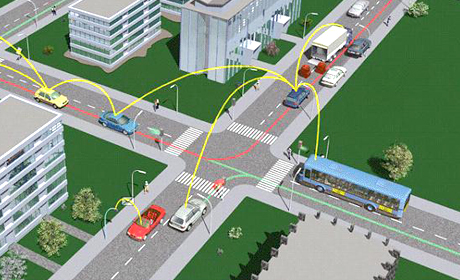Cockrell School faculty are tackling a big-picture wireless initiative, Network of Systems Vision, combining communication and computation in never-before-imagined ways.
 Imagine you’re driving home from work, the GPS system in your car collecting data from sensors and choosing a route that minimizes traffic delays and minimizes fuel consumption. As you get closer to home, the car’s computer communicates with your home network, adjusting the thermostat and pre-heating the oven. Then a traffic-monitoring network detects an accident as it happens immediately in front of you, and sends a signal to your car to brake and turn onto an alternate route. A body sensor records the few beats your heart skipped, and sends that data to your doctor for reference at your next check-up. If the fibrillations progressed into a heart attack, those sensors could even stop your car and call an ambulance.
Imagine you’re driving home from work, the GPS system in your car collecting data from sensors and choosing a route that minimizes traffic delays and minimizes fuel consumption. As you get closer to home, the car’s computer communicates with your home network, adjusting the thermostat and pre-heating the oven. Then a traffic-monitoring network detects an accident as it happens immediately in front of you, and sends a signal to your car to brake and turn onto an alternate route. A body sensor records the few beats your heart skipped, and sends that data to your doctor for reference at your next check-up. If the fibrillations progressed into a heart attack, those sensors could even stop your car and call an ambulance.Previously the stuff of science fiction, this scenario looks plausible to Cockrell School faculty working on the Network of Systems Vision. This big-picture project pulls together existing centers of excellence in wireless communication, circuit design, and computer architecture to enable new applications that combine communication and computation in never-before-imagined ways.
“A lot of academic research is focused on a single component, leading to solutions that assume only one component can be changed,”says Derek Chiou, PhD, assistant professor in the Department of Electrical and Computer Engineering (ECE). “If you look at the entire system, it’s possible to create much better solutions, but those solutions may require changes to many components.”
This vision of what could be accomplished might eventually involve dozens of faculty in the Cockrell School and elsewhere in the university. It includes research areas spearheaded by Chiou; Robert Heath, PhD, associate professor in ECE and associate director of the Wireless Networking and Communications Group; and Andreas Gerstlauer, assistant professor in ECE.
“The basic vision is interactions of networks of networks and systems of systems, driven by new applications, all talking together,” Heath says. Smart highways where cars automatically avoid accidents, or a smart energy grid that deploys sensors to monitor delivery of energy, are examples. “There is already a huge amount of intelligence out there. Coupling together multiple networks and systems, layering them on top of each other where they work both in parallel and in tandem, increases the possibilities.”
A network consists of a set of interconnected nodes. Cellular telephone service is one example, transportation and energy grids are another, and many people are familiar with social networks. A system is a group of independent but interrelated elements acting as a whole, different entities cooperating together for one common goal. The electric utility plant, transmission lines, power stations, and individual meters, for example, form a system.
In addition to looking at the big picture, the project also relies on collaboration. “UT has the right environment to foster collaboration,” Heath says. “People are genuinely interested in working with each other, and Dean Greg Fenves really promotes collaboration. Other universities have related expertise, but we also have people who are willing to work together to push these boundaries. Otherwise, people would talk but nothing would ever happen.”
The project identified three key research vectors: applications, computation/communication co-design, and integrated design methodology and tools. “If we break down the barriers between networks and systems, and integrate across fields, layers and abstractions, then we enable whole new optimizations,” said Gerstlauer. “We’re adding a new layer of new types of applications, with an underlying networks-of-systems infrastructure, supported by new design tools that enable them to become smart. It’s a holistic approach, taking traditionally separated areas of expertise and getting them to talk with each other, so that we can design, build, and optimize together.”
Rather than one group designing hardware and a separate group creating software, or different groups building computation and communication subsystems, for example, all work together to co-design a better system.
One of the immediate outcomes of the project for Heath has been getting to know other faculty in the Cockrell School. “We have a very large faculty, and some of them are doing cool stuff that might be related, but you don’t know about it,” he says. “In a sense, we’re creating a framework that will be used in many ways, that will allow people to say, this is how I can use this idea in my area.” The end result is solving problems more effectively.
“By merging our expertise, we can make more intelligent decisions,” Gerstlauer says. “That’s what the ‘smart’ buzzword means. Linking networks enables information to flow more freely, and by adding the capability of processing that information at the same time, you make better decisions.”
There are many things that existing networks and systems are already capable of doing, but integrating those capabilities to get more interesting functionality isn’t currently practical, Chiou says. “We can innovate in the integration of isolated capabilities into larger systems. Let’s think big, dream what we can do, and then figure out how it can be done with the components we already have and those we may need to design and build. By bringing experts from different fields together and looking at the problem as a whole system, rather than isolated components, we can create something that is much bigger than the sum of its parts.”







